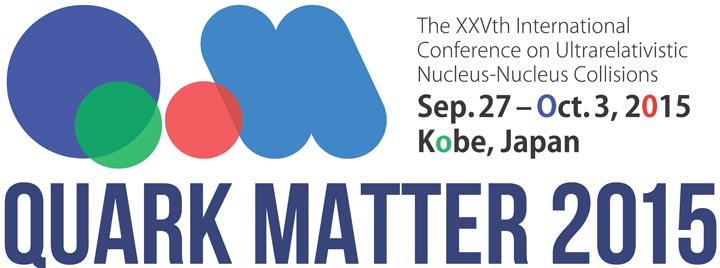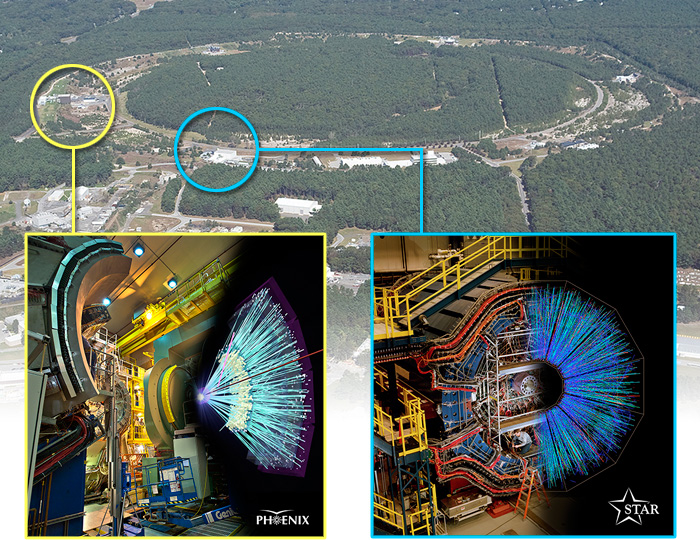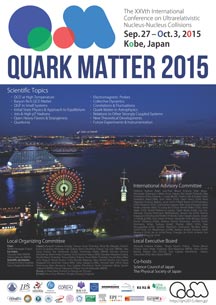Quark Matter 2015: Scientists Present, Discuss Latest Data from Experiments Smashing Nuclei at the Speed of Light
Details of particle smashups at RHIC and the LHC offer insight into the building blocks of matter and the hearts of neutron stars
October 1, 2015

Kobe, JAPAN—Scientists intent on unraveling the mystery of the force that binds the building blocks of visible matter are gathered in Kobe, Japan, this week to present and discuss the latest results from "ultrarelativistic nucleus-nucleus collisions." Known more colloquially as Quark Matter 2015, the conference convenes scientists studying smashups of nuclei traveling close to the speed of light at the world's premier particle colliders—the Relativistic Heavy Ion Collider (RHIC) at the U.S. Department of Energy's Brookhaven National Laboratory, and the Large Hadron Collider (LHC) at the European Center for Nuclear Research (CERN). These collisions momentarily recreate the extreme conditions of the early universe so scientists can study quarks and gluons, the building blocks of ordinary protons and neutrons, as they existed and interacted nearly 14 billion years ago, before becoming bound by the strong nuclear force to form the atoms of the visible universe today.

The PHENIX and STAR detectors (insets) are located at points on the 2.4-mile-circumference Relativistic Heavy Ion Collider where the two collider rings intersect so particles can collide. Tracing the paths of particles created in these collisions reveals information about the building blocks of ordinary protons and neutrons as they existed and interacted nearly 14 billion years ago.
"These results are the product of the ever-improving capabilities of the RHIC detectors and the accelerator."
— Berndt Mueller, Brookhaven Lab's Associate Director for Nuclear and Particle Physics
The last few years have yielded a series of intriguing results that RHIC, in particular, has the unique ability to explore in depth by colliding many different types of nuclei over a wide range of energies. Members of STAR and PHENIX, the two scientific collaborations conducting nuclear physics research at this DOE Office of Science User Facility—along with theorists analyzing and guiding the research and colleagues working on complementary studies at the LHC—are eager to share the latest insight.
"We're particularly excited about the breadth of new results that PHENIX will be showing in Kobe," said Brookhaven physicist Dave Morrison, a co-spokesperson for the PHENIX collaboration. "We explain our key analyses in scientific papers that we've recently submitted to peer-reviewed journals."
"STAR will be presenting the first scientific results from recent detector upgrades, which showcase our ability to probe the behavior of distinct types of particles over a wide range of energies," said Brookhaven physicist Zhangbu Xu, spokesperson for the STAR collaboration. "These data are helping us map out the only phase diagram involving the strong nuclear force and lay the foundation for future experiments at RHIC."
Click on the headings below to learn more about the latest RHIC results
The smallest quark-gluon plasma (QGP)
Mapping the phase diagram of quark matter
Restoration of a crucial symmetry and effects from fleeting fields
"These are just the highlights among the many new results STAR and PHENIX are presenting at Quark Matter 2015," said Berndt Mueller, Associate Laboratory Director for Nuclear and Particle Physics at Brookhaven Lab. "They are the product of the ever-improving capabilities of these detectors and the accelerator. And they showcase how a global community of dedicated scientists is taking full advantage of RHIC's remarkable versatility to explore in depth the structure of nuclear matter over a wide range of temperatures and densities.
"As always," Mueller continued, "the discussions that take place during this meeting will play an important part in fine-tuning the future research plans at RHIC. When many of the leading experts in the field convene at one place, the often quite heated discussions are certain to move the field forward."
Research at RHIC is funded primarily by the U.S. Department of Energy's Office of Science (NP) and by these agencies and organizations.
Brookhaven National Laboratory is supported by the Office of Science of the U.S. Department of Energy. The Office of Science is the single largest supporter of basic research in the physical sciences in the United States, and is working to address some of the most pressing challenges of our time. For more information, please visit science.energy.gov.
2015-11772 | INT/EXT | Newsroom










